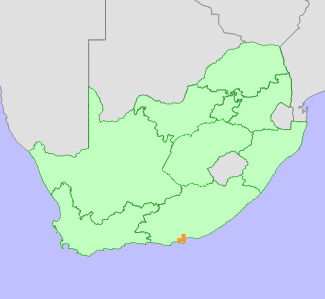|
Scientific Name | Euphorbia globosa (Haw.) Sims |
Higher Classification | Dicotyledons |
Family | EUPHORBIACEAE |
Synonyms | Dactylanthes globosa Haw., Euphorbia glomerata A.Berger, Medusea globosa (Haw.) Klotzsch & Garcke |
Common Names | Eierpol (a), Knopmelkbol (a) |
National Status |
Status and Criteria | Critically Endangered A2acd+4acd |
Assessment Date | 2022/09/18 |
Assessor(s) | N.N. Mhlongo & T. Variawa |
Justification | This species has a limited distribution range and has an extent of occurrence (EOO) of 528 km². It has experienced a population reduction of over 90% in the past two generations (at least 60 years) due to illegal collection for the specialist succulent trade and habitat loss due to coastal developments. It is also threatened by ongoing habitat degradation due to trampling, grazing and pollution. It therefore qualifies as Critically Endangered under criterion A. |
Distribution |
Endemism | South African endemic |
Provincial distribution | Eastern Cape |
Range | This species is endemic to the Eastern Cape Province, where it occurs from Port Elizabeth to Uitenhage. |
Habitat and Ecology |
Major system | Terrestrial |
Major habitats | Kouga Grassy Sandstone Fynbos, Albany Alluvial Vegetation, Sundays Valley Thicket, Motherwell Karroid Thicket, Grass Ridge Bontveld |
Description | It grows in low, stony hills not further than 20 km from the coast, in full sun. |
Threats |
| This species was historically threatened by coastal developments in the Port Elizabeth area, which resulted in severely fragmented subpopulations due to habitat loss. The population occurs in an area of increasing urbanisation and human impacts such as pollution (sewage and dumping) and trampling by both humans and livestock has been reported. The ongoing grazing on communal lands, where most of the subpopulations are found, is likely to result in habitat degradation and loss in the future. The current biggest threat to this species though is the illegal collection of plants to supply the international horticulture trade. Available records from the CITES trade database show that 27 531 plants have been exported from South Africa since 1983 which are suspected to have been wild collected. A nursery which had been the sole exporter of this species was raided in 2019 and over 13 000 distinctly wild specimens of this species were found at their premises. This nursery has subsequently been shut down. |
Population |
Based on field surveys conducted in 2019 the population is estimated to be fewer than 2500 plants. The subpopulations are small and occur in isolated patches. The larger subpopulations mostly occur on communal lands where they are vulnerable to habitat loss and degradation due to rubbish dumping, grazing and trampling by livestock. Only four of the subpopulations have more than 100 mature individuals, while the rest all have less than 100 mature individuals. The population has experienced a loss of more than 90% in the last two generations, with 40 531 plants recorded to be illegally collected, and many more mature individuals likely to have been lost as a result of habitat loss and degradation.
|
Population trend | Decreasing |
Assessment History |
Taxon assessed |
Status and Criteria |
Citation/Red List version | | Euphorbia globosa (Haw.) Sims | EN B1ab(ii,iii,v) | Raimondo et al. (2009) | | Euphorbia globosa (Haw.) Sims | Rare | Hilton-Taylor (1996) | |
Bibliography |
Goldblatt, P. and Manning, J.C. 2000. Cape Plants: A conspectus of the Cape Flora of South Africa. Strelitzia 9. National Botanical Institute, Cape Town.
Hilton-Taylor, C. 1996. Red data list of southern African plants. Strelitzia 4. South African National Botanical Institute, Pretoria.
Raimondo, D., von Staden, L., Foden, W., Victor, J.E., Helme, N.A., Turner, R.C., Kamundi, D.A. and Manyama, P.A. 2009. Red List of South African Plants. Strelitzia 25. South African National Biodiversity Institute, Pretoria.
|
Citation |
| Mhlongo, N.N. & Variawa, T. 2022. Euphorbia globosa (Haw.) Sims. National Assessment: Red List of South African Plants version 2024.1. Accessed on 2025/10/27 |
 Comment on this assessment
Comment on this assessment

